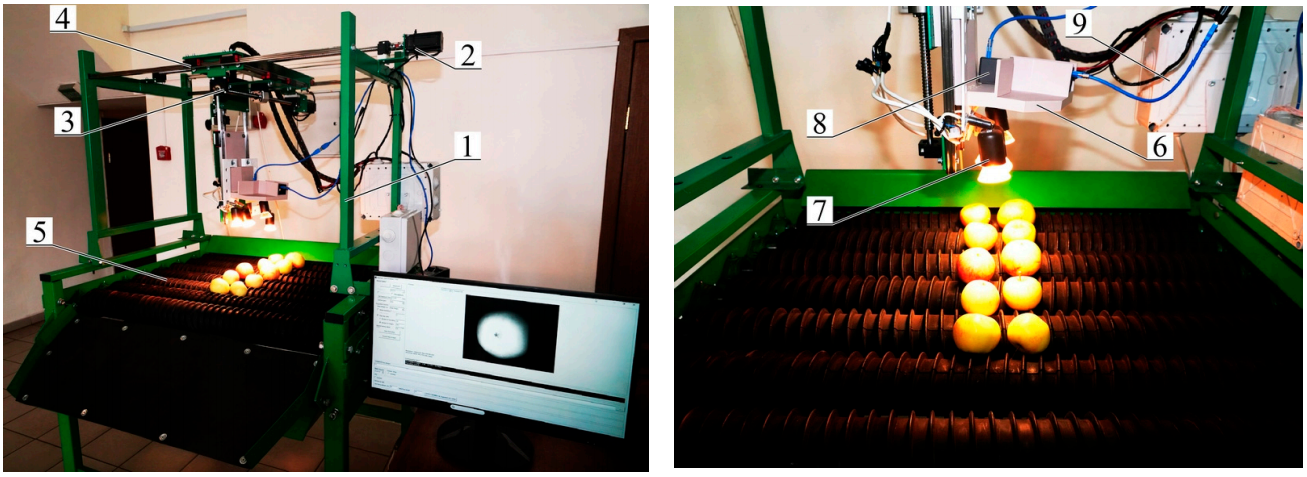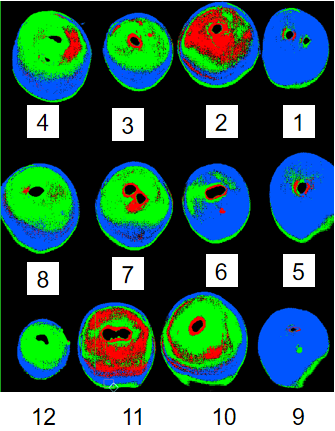Hyperspectral Imaging: An Inside View of Food Quality
舌尖上的中国,早已告别“吃饱就行”的时代。如今,我们追求的是更高品质、更安全放心的食品。高光谱成像技术作为一种新兴的技术,它能像“火眼金睛”一样,穿透食品的表象,检测其内在的成分、品质和安全状况。下面,让我们一起走进高光谱成像技术在食品行业的应用巡礼。
In China, the era of being satisfied with merely "having enough to eat" is long gone. Today, we pursue higher quality, safer, and more reliable food. As an emerging technology, hyperspectral imaging can penetrate the surface of food products—much like having "eyes that see beneath the surface"—to detect their internal composition, quality, and safety conditions. Below, let’s explore the applications of hyperspectral imaging technology in the food industry.
农产品的品质检测 / Quality Inspection of Agricultural Products
高光谱成像在农产品分选中,尤其擅长进行无损检测,发现肉眼难以察觉的内部损伤。例如,它可以检测苹果外表可能看不见的瘀伤或内部损伤,实现更精准的分级,提升产品价值。这种非破坏性的检测方式,能够帮助生产者剔除存在潜在质量问题的产品,提升整体的产品质量和市场竞争力。
Hyperspectral imaging excels in the non-destructive inspection of agricultural products, particularly in sorting operations. It can detect internal damage that is difficult to see with the naked eye. For example, it can identify bruises or internal defects in apples that are not visible externally, enabling more accurate grading and enhancing product value. This non-destructive testing method helps producers remove items with potential quality issues, thereby improving overall product quality and market competitiveness.

基于高光谱的苹果分选 / Hyperspectral-Based Apple Sorting
农产品的感官特征评价 / Evaluation of Sensory Characteristics in Agricultural Products
感官特征,如糖度、酸度、硬度和成熟度,直接影响消费者对农产品的喜好。高光谱成像技术在食品感官评价中展现出巨大潜力,能够无损地预测这些关键指标。例如,通过分析柿子在特定波长的反射率,可以建立涩味预测模型;通过分析葡萄在近红外波段的光谱吸收特征,可以预测其糖度和酸度。与传统感官评价方法相比,高光谱成像具有快速、客观、无损的优点。
Sensory attributes such as sugar content, acidity, firmness, and ripeness directly influence consumer preference for agricultural products. Hyperspectral imaging shows great potential in the sensory evaluation of food, as it can non-destructively predict these key indicators. For instance, by analyzing the reflectance of persimmons at specific wavelengths, a prediction model for astringency can be developed. Similarly, by examining the spectral absorption features of grapes in the near-infrared range, their sugar and acid levels can be predicted. Compared with traditional sensory evaluation methods, hyperspectral imaging offers the advantages of speed, objectivity, and non-destructiveness.

使用高光谱技术实时在线检测葡萄糖度 / Real-Time Online Detection of Grape Sugar Content Using Hyperspectral Technology
茶叶品质评估 / Tea Quality Assessment
通过分析茶叶的光谱信息,可以无损、精确地分析茶叶中的生物活性成分,如茶多酚、咖啡碱和氨基酸等,这些成分对茶叶的风味和品质至关重要。某团队利用高光谱数据建立了模型,可以准确估计茶叶中的茶多酚含量。另一团队利用无人机搭载的高光谱相机,预测茶多酚和氨基酸含量,并评估茶多酚与氨基酸比值。
By analyzing the spectral information of tea leaves, key bioactive components such as tea polyphenols, caffeine, and amino acids—which are crucial to the flavor and quality of tea—can be assessed accurately and non-destructively. One research team developed a model based on hyperspectral data to accurately estimate the content of tea polyphenols. Another team used a drone-mounted hyperspectral camera to predict the contents of tea polyphenols and amino acids, and further evaluated the ratio between the two.
肉品质量评估 / Meat Quality Assessment
高光谱成像可准确测量脂肪和蛋白质含量,评估营养价值和风味。例如,分析牛肉大理石花纹预测嫩度和多汁性,或评估鱼类蛋白质降解程度判断新鲜度,区分正常胸肉和“木质胸肉”,它不仅能优化利用率,还能检测骨碎片等异物,确保食品安全。
Hyperspectral imaging can accurately measure fat and protein content, helping to evaluate nutritional value and flavor profiles. For example, it can analyze the marbling of beef to predict tenderness and juiciness, or assess the degree of protein degradation in fish to determine freshness. It is also capable of distinguishing between normal chicken breast and woody breast, and can detect foreign materials such as bone fragments—enhancing utilization efficiency while ensuring food safety.

利用高光谱技术区分鸡胸肉肉质 / Differentiating Chicken Breast Meat Quality Using Hyperspectral Technology
高光谱成像技术作为新兴的食品检测手段,潜力巨大。尽管数据处理、设备成本和应用场景复杂性带来挑战,但人工智能和机器学习的快速发展,为高光谱成像技术带来了新的机遇。通过结合大数据分析与建模,有望进一步提高食品品质预测的准确性,实现农产品等产业链的智能化升级,从生产到加工再到销售,带来更高效、更有品质保障的生产模式。
As an emerging tool in food inspection, hyperspectral imaging holds significant potential. Although challenges remain in data processing, equipment costs, and the complexity of application scenarios, the rapid development of artificial intelligence and machine learning presents new opportunities for the technology. By integrating big data analysis and modeling, hyperspectral imaging is expected to further improve the accuracy of food quality prediction and enable intelligent upgrades across agricultural and food production chains—from production and processing to sales—paving the way for more efficient and quality-assured production models.
上一篇:没有了
 客服热线:400-688-7769
客服热线:400-688-7769 邮箱:market@exponentsci.com
邮箱:market@exponentsci.com 固话:020-89858550
固话:020-89858550 地址:广州市天河区广汕二路602号惠诚大厦B座403房
地址:广州市天河区广汕二路602号惠诚大厦B座403房
扫一扫 微信咨询
©2025 爱博能(广州)科学技术有限公司 版权所有 备案号:粤ICP备20046466号 技术支持:化工仪器网 Sitemap.xml 总访问量:89928 管理登陆